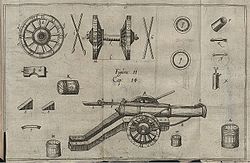Characteristics
Kartouwen were developed from bombards. [1] A kartouwe has a caliber of 8 inches (200 mm), weighs about 8,000 pounds (3,600 kg), and is designed to fire cannonballs weighing up to 52 pounds (24 kg). [6] As a minimum, twenty horses or oxen were needed to move a kartouwe. [6]
In addition to "whole" ("hele") kartouwen, there were also double, [7] half ("halve") [8] and quarter kartouwen. [4] The barrel of a whole kartouwe has a length of 18 to 19 times the caliber, weighs 3,000 kilograms (6,600 lb) to 3,500 kilograms (7,700 lb) and was transported on a special wagon by 20 to 24 horses, another four to eight horses were needed to transport the mount (lafette). [9] The barrel length of a half-kartouwe is 32 to 34 times the caliber, which ranges between 105 millimetres (4.1 in) and 115 millimetres (4.5 in). [9] Its barrel weighs 1,100 kilograms (2,400 lb) to 1,500 kilograms (3,300 lb), the whole gun 1,700 kilograms (3,700 lb) to 2,400 kilograms (5,300 lb). [9] Half-kartouwen fired cannonballs weighing between 8 pounds (3.6 kg) and 10 pounds (4.5 kg), and for the transport of its barrel, 10 to 16 horses were needed. [9]
The huge size of the cannon and the weight of its 48-pound projectiles (standard value, though real projectiles could vary from 30 to 60 pounds) made it onerous to maneuver and reload. William P. Guthrie estimates that a single kartouwe averaged only 8 to 10 shots under sustained combat conditions, half to a third as much as the more common 3 to 6 pounder field guns, though in all cases "well-drilled troops could shave these times." [10]
Use and perception
Kartouwen were used for example in the Livonian War by the Russian [5] and Swedish forces. [7] During the Battle of Narva (1581), the besieging Swedish forces destroyed the walls of Narva, 5.5 metres (18 ft) strong, within two days using twenty-four double and half-kartouwen. [7]
Kartouwen were also the characteristic of the Thirty Years' War. [11] As such, they were featured in contemporary poems, [11] e.g. in Am liebsten bey der Liebsten by Sibylla Schwarz ("grausame Kartaune", "gruesome kartouwe") and Tränen des Vaterlandes, anno 1636 by Andreas Gryphius ("donnernde Karthaun'", "thundering kartouwe"). [12] [13] In his 1844 poem Die Tendenz, Heinrich Heine used kartouwen to symbolize loudness. [14]
This page is based on this
Wikipedia article Text is available under the
CC BY-SA 4.0 license; additional terms may apply.
Images, videos and audio are available under their respective licenses.



